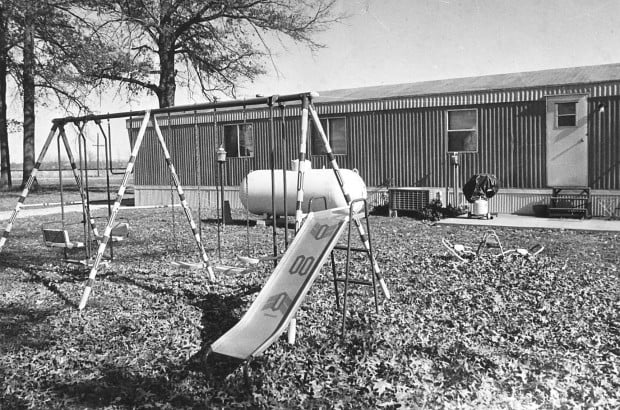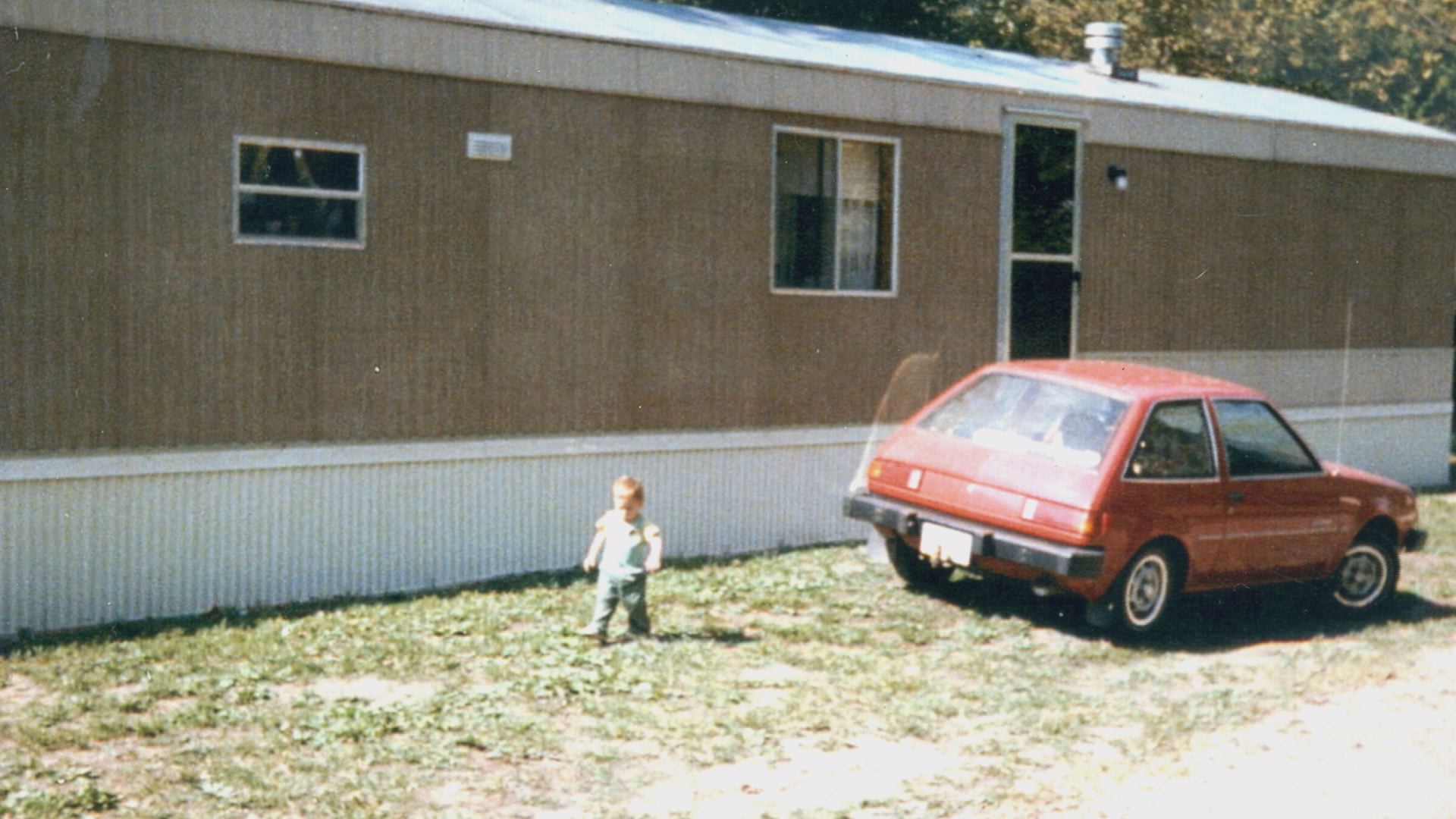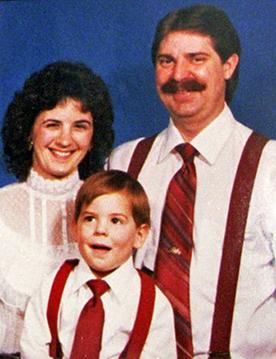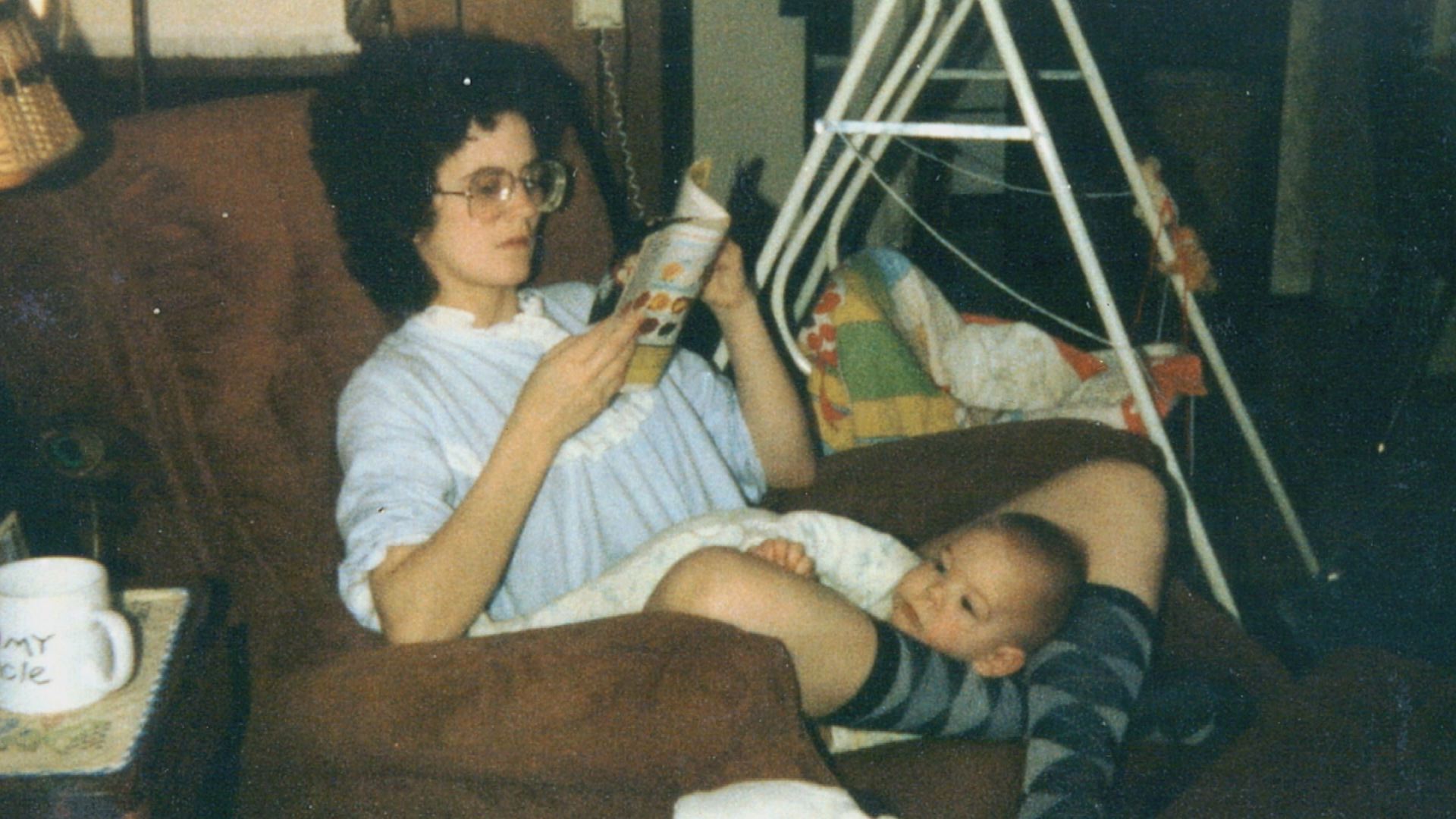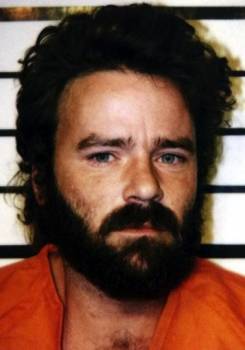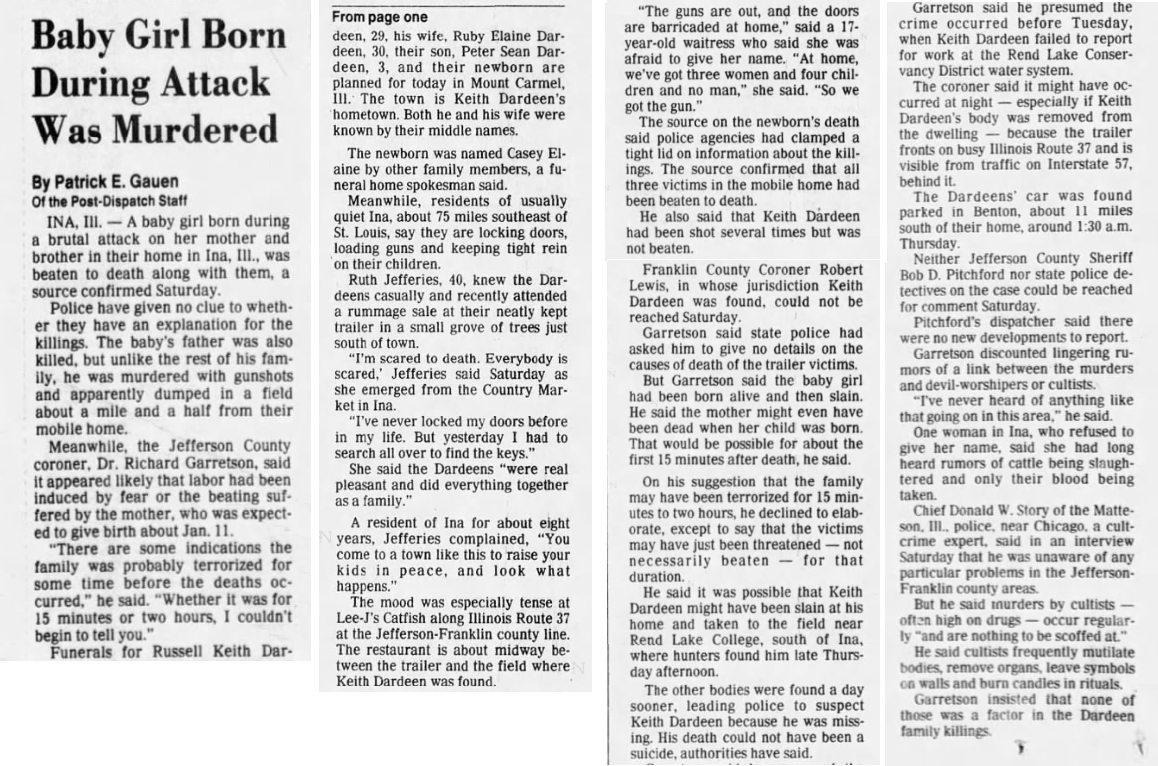Keith and Elaine Dardeen: A Family Trying to Escape Death

November 1987. A young family in rural Illinois was weeks away from escaping a wave of unsolved murders. Keith didn't show up for work. Police found his pregnant wife, his toddler son, and a newborn baby girl dead in their waterbed. Keith was in a field nearby, shot and mutilated. The crime scene was so brutal that detectives who worked it still can't talk about it. Thirty years later, a serial killer on death row confessed. But his story had holes. The evidence is still sitting in storage. The DNA is still waiting. And somebody out there knows exactly what happened that night.
The Dardeen Family Murders: Four Lives Taken in One Horrifying Night
Getting Out While They Still Could
Keith and Elaine Dardeen were planning their escape. They lived in a mobile home just outside Ina, Illinois. Population 460. The kind of place where you know your neighbors, where kids ride bikes until dark, where people leave their doors unlocked. At least, they used to.
Something had changed in Southern Illinois. Between 1985 and late 1987, at least ten people had been murdered across Jefferson and Franklin counties. Could have been fifteen. Nobody really knew. The cases stayed unsolved. Local police had leads that went nowhere. Fear started creeping into conversations at the grocery store, at church, at the water plant where Keith worked.
Keith felt it deeply. People close to him said he talked about the murders, about wanting to get his family somewhere safer. So he and Elaine decided to move back to Mount Carmel, her hometown. They were packing up, making plans, looking forward to a fresh start.
Elaine was seven months pregnant. Their second child. They already had three-year-old Peter, who was excited about becoming a big brother. They'd even picked out names. Casey if the baby was a girl. Ian for a boy. The due date was January 11th, 1988. They had time. They thought they had time.
Keith showed up for work every single day. Reliable, steady, the kind of employee supervisors love. He worked at the local water plant, and his shift started at seven a.m. on November 18th, 1987. When he didn't arrive that morning, his supervisor immediately knew something was off. He called Keith's parents, Russell and Joanne Dardeen. They called the Jefferson County Sheriff's office and asked for a welfare check.
Inside the Mobile Home
Deputies got to the Dardeen home and found the front door locked. They walked around back, tried that door, and it opened. The second they stepped inside, they saw blood. Everywhere. The kind of scene where you take a breath, steady yourself, and prepare for the worst thing you've ever seen.
They walked to the master bedroom and found three bodies in the waterbed. Elaine Dardeen, 30 years old. Peter Dardeen, three years old. And a baby. A newborn baby girl.
The coroner pieced together what happened. Someone had beaten Elaine with such force, such sustained violence, that her body went into shock and premature labor. She gave birth in that bedroom while she was dying. The baby came into the world and lived for maybe minutes before the killer beat her to death too. Peter died the same way. Blunt force trauma. A baseball bat. The same baseball bat Keith had given Peter for his birthday earlier that year.
Elaine and Peter had been bound with duct tape. Gagged. Unable to scream, unable to fight back, unable to do anything while someone beat them to death.
Detectives who worked this case, people who'd spent decades in law enforcement, people who'd seen horrific things, called this the worst murder scene of their entire careers. Think about that. These are professionals who've worked countless homicides. And this one still haunts them.
After all that rage, all that violence, the killer did something really strange. They took the bedding and carefully wrapped up Elaine, Peter, and the newborn baby. Then they tucked all three of them into the waterbed. Neatly. Like tucking children in for the night.
That kind of shift tells you something about the person who did this. Going from absolute fury to this careful, almost tender arrangement of bodies. That's rare. That suggests someone who either knew this family personally or someone who had a ritual they needed to complete. The staging meant something. It had purpose.
Keith was gone. Police initially wondered if maybe he'd done this and run. That's the first theory you explore when a husband and father is missing from a scene like this.
Finding Keith
The next day, November 19th, they found Keith in a field nearby. He'd been shot. Three times. Execution style. And then someone had mutilated his genitals after he was already dead. His penis had been severed.
That kind of mutilation is deeply personal. It's about power, about rage, about destroying someone's masculinity. It screams vendetta. Whoever killed Keith wanted him to suffer in a very specific way. They wanted to send a message.
The medical examiner determined that Keith died within an hour of his family. Everything happened in one compressed window of time. Late on November 17th into the early morning hours of November 18th. One person, or maybe more than one, killed four people in less than an hour.
Keith's car turned up near the police station in Benton. The killer had driven it there and left it. Blood was spattered inside. The car itself had probably been the place where Keith was shot. Why leave it there? It cleared up the confusion about Keith being a suspect right away. The car sitting there told investigators that Keith was a victim. But it also felt like the killer was playing with them. Leaving evidence right where they'd find it. Showing off.
Thirty Detectives and a Thousand Dead Ends
Jefferson County pulled out all the stops. Thirty full-time detectives got assigned to this case. They tracked down more than a thousand leads. They interviewed over a hundred people. They collected about 150 pieces of evidence from the mobile home and sent samples to labs all over the place.
They came up empty.
The back door had been unlocked. There were signs the killer came in through the back. The front door was locked. Valuables were still there. Cash sitting in plain sight. Jewelry. A video camera. Nothing had been stolen.
Police were dealing with a crime that was clearly targeted. Someone had gone to that mobile home specifically to kill the Dardeens. But why? What was the motive?
Rumors spread fast in a town that small. People started whispering about Satanism, about occult rituals. Investigators looked into it and ruled it out quickly. They also dug into possible drug connections, gambling debts, affairs. None of it panned out.
Keith's mother, Joeann, spent years thinking about why someone would do this to her son and his family. In 1997, she shared some theories with investigators. Maybe someone had wanted Keith to sell drugs and he refused. Maybe someone had been obsessed with Elaine, tried to pursue her, and she turned him down. Maybe that rejection turned into rage directed at the whole family.
Another theory on the table was mistaken identity. Maybe the killer thought the Dardeens were someone else. Maybe they'd gone to the wrong mobile home by accident.
The physical evidence pointed to a targeted attack. But the lack of obvious motive meant the case went cold within months. Detectives exhausted every lead they had and came up with nothing.
Tommy Lynn Sells Confesses from Death Row
The case sat quiet for years. Then, sometime in the early 2000s, a serial killer on death row in Texas claimed he'd done it. His name was Tommy Lynn Sells.
Sells was already convicted of murdering a teenage girl. He was waiting for execution. And he was a talker. He confessed to dozens of murders all across the country. Some of those confessions were real. A lot of them were probably lies. Sells had a pattern of inserting himself into famous unsolved cases, changing his story, making things up. He was like Henry Lee Lucas, another serial killer who confessed to hundreds of murders he probably had nothing to do with.
But Sells said he killed the Dardeens. His confession included a lot of accurate details. Things that had been in newspaper articles. Things anyone could have looked up. The stuff that was public knowledge lined up with what he said.
The problem came with the details that had never been made public. Things only the killer would know. When Illinois investigators dug deeper into his story, they found inconsistencies. Facts about the crime scene that Sells got wrong. And he changed his story three times about how he'd even met the Dardeen family in the first place.
One version, he said he met Keith at a truck stop or maybe a pool hall. Keith invited him to dinner. Then Keith supposedly propositioned him for a threesome with Elaine. Another version, he saw a "For Sale" sign on the trailer, knocked on the door pretending he wanted to buy it, overpowered Keith, and forced him to bind and gag his own wife and son before driving him to the field.
Detectives rejected these claims. They'd investigated every aspect of Keith's life back in 1987. Nothing in their investigation supported anything Sells was saying. Keith had been so protective of his family after a local girl was raped and murdered in May 1987 that he once refused to let a young woman use his phone when she knocked on the door at night. The idea that he'd invite a stranger home for dinner, or that he'd proposition that stranger sexually, made absolutely zero sense to anyone who knew him.
Investigators believed Sells invented these details to make himself feel better about what he'd done. To shift blame onto the victim. To justify the murders in his own twisted mind.
Illinois investigators wanted to bring Sells to Ina. Walk him through the crime scene. See if he could provide information that only the real killer would know. Texas refused. State law prohibited moving death row inmates out of Texas for any reason. That was it. The end of the road. The Jefferson County State's Attorney declined to file charges based on a confession that had too many holes and couldn't be properly verified.
Tommy Lynn Sells was executed in Texas in 2014. He never came to Illinois. The Dardeen case stayed cold.
Tommy Lynn Sells - Serial Killer
The Evidence is Still Waiting
All that evidence collected in 1987 is still sitting in storage. DNA samples from the victims are preserved and cataloged. Those 150 items from the scene are logged and ready for testing.
Think about what happened in that mobile home. The killer spent significant time there. They beat three people to death in a sustained, prolonged attack. They moved bodies. They wrapped bedding. They staged the scene. There's biological material somewhere in that evidence. Has to be. Skin cells, hair, sweat, blood. Something the killer left behind.
Modern forensic genetic genealogy has solved cases that seemed impossible. Investigators can take a DNA profile and match it to distant relatives through genealogy databases. They can build family trees and identify suspects decades after the crime. The Golden State Killer case proved how effective this technique can be.
The Dardeen case is a perfect candidate for this kind of work. The challenge is isolating a clean suspect profile from the evidence. Getting DNA that belonged to the killer. Once that's done, once investigators have one solid genetic profile, they can submit it for genealogical analysis.
Someone walked into that mobile home on November 17th, 1987. Someone filled with rage. Someone who bound a pregnant woman and a toddler with duct tape and beat them to death with a baseball bat. Someone who killed a newborn baby minutes after she was born. Someone who then shot and mutilated Keith Dardeen in a field. Someone who staged the scene and left Keith's car by the police station.
That person either died years ago, carrying the secret with them, or they're still alive. Still out there. Living with what they did. Knowing that four people are dead because of them.
Keith and Elaine were trying to escape the wave of violence that had terrorized their community. They were weeks away from moving to safety. They were almost out.
The science exists to solve this case. The evidence is there. It's a matter of someone deciding that after 38 years, the Dardeen family deserves answers. They deserve justice. And someone needs to be held accountable for what happened in Ina, Illinois, on that November night in 1987.

